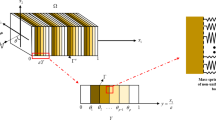Abstract
The behaviour of a laminated plate with given boundary temperatures and displacement constraints may be tailored by varying the orientation of the reinforcement in the different layers. Because the material parameters in a thermal conductivity problem, as also in a structural problem, depend on the orientations of the layers, there is a coupled-field problem to be solved. FEM is applied here to the analysis of such problems, which now consists of two phases in each iteration cycle: first solution of the temperature distribution over the structure and then computation of the displacements, stresses and strains. Strain energy and the sum of selected displacements for the structure are minimized with respect to the fibre orientations in the layers. Only mid-plane symmetric laminates with constant temperature over the thickness are considered, i.e. the response of the laminate is restricted to in-plane behaviour. Mathematically, the problem is a nonlinear one, and thus the minimum point can be either a local or a global one. The gradients needed during minimization are computed analytically. Examples with different numbers of design variables are given.
Similar content being viewed by others
References
Arora, J.S. 1990: Computational design optimisation: a review and future directions.Struct. Safety 7, 131–148
Autio, M.; Pramila, A. 1995: Inverse problems in thermoelasticity of composites.Proc. 15-th Canadian Cong. of Applied Mechanics (held in Victoria, Canada) 1, pp. 282–283
Callahan, K.J.; Weeks, G.E. 1992: Optimum design of composite laminates using genetic algorithms.Comp. Engrg. 2, 149–160
Cesari, F. 1994: Simple programmes on thermoelastic analysis of composite laminate materials.Comp. & Struct. 53, 551–567
Cook, R.D.; Malkus, D.S.; Plesha, M.E. 1989:Concepts and applications of finite element analysis. New York: John Wiley & Sons
Fukunaga, H.; Sekine, H.; Sato, M. 1994: Optimal design of symmetric laminated plates for fundamental frequency.J. Sound & Vib. 171, 219–229
Grenestedt, J.L. 1990: Composite plate optimization only requires one parameter,Struct. Optim. 2, 29–37
Haftka, R.T.; Grudal, Z.; Kamat, M.P. 1990:Elements of structural optimization. Dordrecht: Kluwer
Hammer, V.B.; Bendsøe, M.P.; Lipton, R.; Pedersen, P. 1995: Parametrization in laminate design for optimal compliance.Report No. 503. Danish Center for Applied Mathematics and Mechanics, The Thecnical University of Denmark
Mesquita, L.; Kamat, M. 1987: Optimization of stiffened laminated composite plates with frequency constraints.Eng. Opt. 11, 77–88
Miki, M. 1985: Design of laminated fibrous composite plates with required flexural stiffness.ASTM, STP-864, 387–400
Mukherjee, N.; Sinha, P. K. 1993: A finite element analysis of inplane thermostructural behavior of composite plates.J. Reinf. Plas. Comp. 12, 1026–1042
Mukherjee, N.; Sinha, P.K. 1994: A comparative finite element heat conduction analysis of laminated composite plates.Comp. & Struct. 52, 505–510
Pedersen, P. 1989: On optimal orientation of orthotropic materials.Struct. Optim. 1, 101–106
Pramila, A. 1990: Extrema and zeros of coefficients of thermal expansion of a balanced symmetric laminate.J. Comp. Mat. 24, 786–794
Ragsdell, K. 1984: The utility of nonlinear programming methods for engineering design. In: Atrek, E.; Gallagher, P. (eds.)New directions in optimum structural design, pp. 385–412. Chichester: John Wiley & Sons
Schittkowski, K. 1985/86: NLPQL:A FORTRAN subroutine solving constrained nonlinear programming problems.Annals Op. Res. 5, 485–500
Author information
Authors and Affiliations
Rights and permissions
About this article
Cite this article
Autio, M. Coupled thermal-structural problems in the optimization of laminated plates. Structural Optimization 15, 49–56 (1998). https://doi.org/10.1007/BF01197437
Received:
Revised:
Issue Date:
DOI: https://doi.org/10.1007/BF01197437




